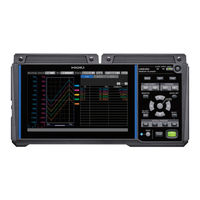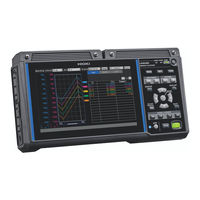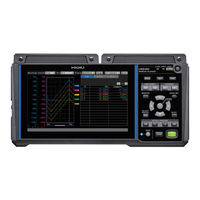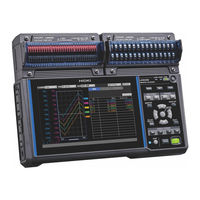Hioki LR8450-01 Manuals
Manuals and User Guides for Hioki LR8450-01. We have 7 Hioki LR8450-01 manuals available for free PDF download: Instruction Manual, Quick Start Manual
Hioki LR8450-01 Instruction Manual (425 pages)
Brand: Hioki
|
Category: Measuring Instruments
|
Size: 16 MB
Table of Contents
-
Instructions13
-
X-Y Compositing103
-
Measurement Data115
-
Trigger Function118
-
Trigger Meanings120
-
Shared Settings121
-
Level Triggers126
-
Window Triggers128
-
CAN Trigger131
-
Formatting Media144
-
Saving Data146
-
Loading Data162
-
Managing Data165
-
Deleting Data167
-
Copying Data169
-
Sorting Files170
-
Checking Alarms187
-
Setting the Time221
-
Trigger Output235
-
Sending Emails289
-
Specifications300
-
U8555 CAN Unit341
-
Measuring Strain379
-
Bending Stress381
-
Torsional Stress382
-
Auto-Balancing383
-
Scan Timing393
-
U8552 and LR8532395
-
U8553 and LR8533396
-
Filenames397
-
Text Format398
-
File Size400
-
Triggers416
-
Alarms417
-
Logger Utility418
-
Data Handling419
-
Index422
Advertisement
Hioki LR8450-01 Instruction Manual (400 pages)
MEMORY HiLOGGER
Brand: Hioki
|
Category: Measuring Instruments
|
Size: 17 MB
Table of Contents
-
-
-
Measurement Data104
-
-
Trigger Meanings109
-
-
Shared Settings110
-
-
-
Level Triggers115
-
Window Triggers117
-
-
-
-
Data
127 -
Formatting Media131
-
Saving Data133
-
Loading Data148
-
Managing Data151
-
-
-
-
-
-
Sending Emails269
-
-
-
Measuring Strain352
-
Scan Timing366
-
Filenames370
-
Text Format371
-
File Size373
-
-
Triggers389
-
Alarms390
-
Logger Utility391
-
Data Handling392
-
Index
395
Hioki LR8450-01 Instruction Manual (310 pages)
Brand: Hioki
|
Category: Data Loggers
|
Size: 13 MB
Table of Contents
-
Instructions10
-
Formatting Media106
-
Saving Data108
-
Loading Data120
-
Managing Data122
-
Deleting Data124
-
Copying Data126
-
Sorting Files127
-
Checking Alarms140
-
Setting the Time170
-
Trigger Output183
-
Specifications234
-
Measuring Strain273
-
Bending Stress274
-
Torsional Stress275
-
Auto-Balancing276
-
Scan Timing285
-
U8552 and LR8532287
-
U8553 and LR8533288
-
Filenames289
-
Text Format290
-
File Size292
-
Data Handling305
-
Index308
Advertisement
Hioki LR8450-01 Quick Start Manual (120 pages)
MEMORY HiLOGGER
Brand: Hioki
|
Category: Data Loggers
|
Size: 7 MB
Table of Contents
-
Safety10
-
1 Overview
25 -
-
-
-
Saving Data85
-
Loading Data85
-
-
-
Index
115
Hioki LR8450-01 Quick Start Manual (96 pages)
Memory HiLOGGER
Brand: Hioki
|
Category: Data Loggers
|
Size: 4 MB
Table of Contents
-
Safety8
-
1 Overview
23 -
-
-
Index
95
Hioki LR8450-01 Quick Start Manual (16 pages)
MEMORY HiLOGGER
Brand: Hioki
|
Category: Data Loggers
|
Size: 5 MB
Hioki LR8450-01 Instruction Manual (2 pages)
Dedicated Plug-In Modules
Brand: Hioki
|
Category: Control Unit
|
Size: 3 MB






